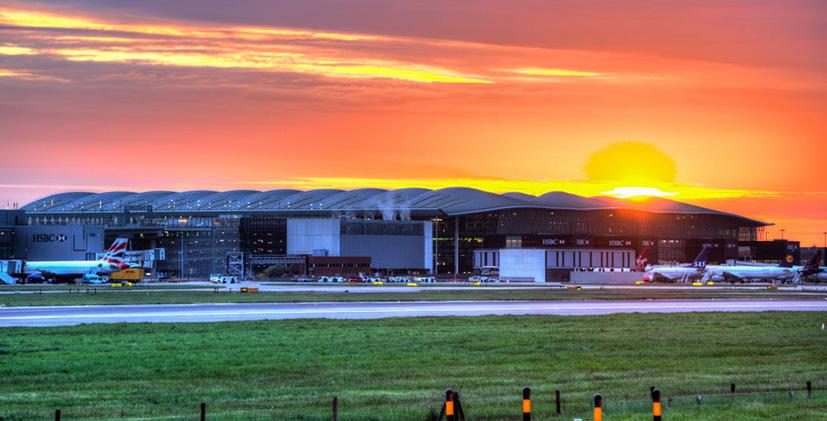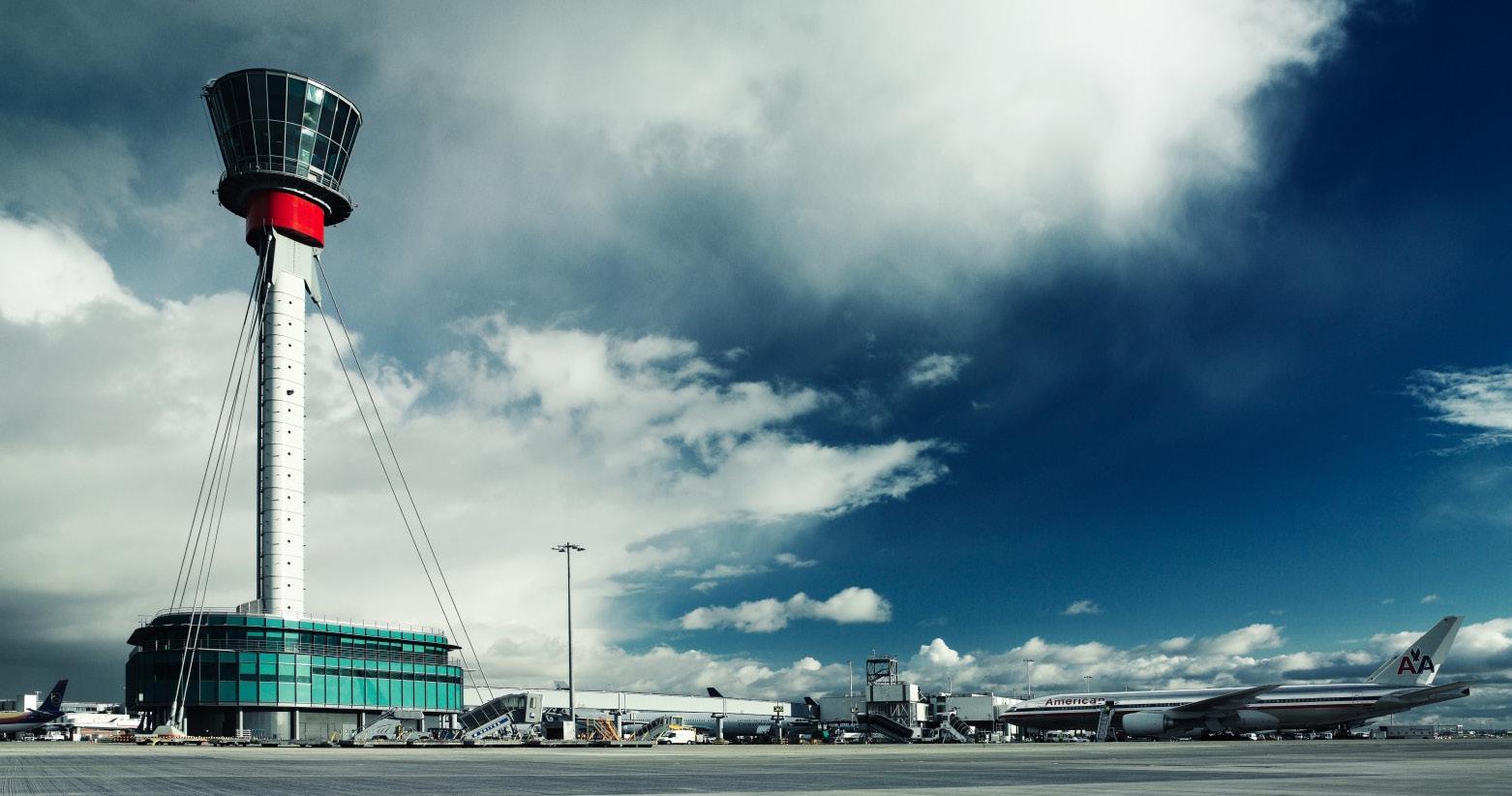





PRODUCTION: James Davey
Aviation 2.0 will start from the innovation hotbed that is Heathrow Airport, the UK’s busiest. As the company works through a sustainability strategy and it’s Heathrow 2.0 journey, progress is being made with every project that is started.
//As one of the biggest, busiest, and most important airports in the world, London’s Heathrow is a true connector of people. It brings opportunity and people together, and is an unquestionable driver of economic activity. But, like every piece of key national infrastructure, in every country, there is room for improvement.
Sustainability in airports and aviation is a hot topic. How can we reach net zero, even if only in transportation, with airports requiring the energy input equivalent to a small country? How can aviation advance from the average flight burning tens of thousands of gallons of jet fuel, releasing significant emissions? And how can we solve these problems while encouraging more and more

flights to take off and land every year?
It’s a highly complex problem, and does not come with a simple fix. At Heathrow, a sustainability strategy was put in place in 2017, but updated in 2022. Heathrow 2.0 is a documented strategy for improvement, focused on sustainability, and has been delivered across the organisation to ensure all stakeholders are part of a different

// HEATHROW IS ONCE AGAIN SERVING AS A TESTBED FOR GROUND-BREAKING TECHNOLOGIES, DEMONSTRATING GLOBAL LEADERSHIP WITH REGARDS TO SUSTAINABLE TRAVEL. //
future for aviation and air travel.
In 2015, the Solar Impulse aircraft landed in Abu Dhabi after completing a flight around the entire world using nothing but the sun’s rays. In 2023, a flight left Heathrow for New York’s JFK powered by sustainable aviation fuel (SAF) made of cooking oils and other plant-based products. Change is possible, and improvement is happening, right above our heads.
Part of Heathrow 2.0 is for the airport to achieve net zero carbon from air travel by 2050. This includes passengers opting to offset emissions through donation to reforestation and SAF projects, and emissions from operations being lowered. It involves the entire value chain, and
will utilise new technologies.
SAF is a key part of reducing environmental impact. Replacing traditional fossil-fuel based products that have been used to power aircraft for generations, SAF reduces carbon emissions by 70% (or more with the introduction of power-to-liquid fuels that currently in development). To produce SAF, traditional fuels are currently blended with other materials for use in jet engines without major alteration. The world’s biggest manufacturers, including Boeing and Airbus, have committed to having engines 100% adapted to use SAF by 2030.
At Heathrow, a groundbreaking system has been developed to encourage the use of SAF by all airlines that pass through the
airport. The Heathrow SAF Incentive Programme, launched in 2022, is a fund of £71 million that can be tapped into by airlines looking to swap to SAF. Up to 155,000 tonnes can be claimed, and this would stop 344,000 tonnes of carbon from flights from entering the atmosphere.
“Sustainable Aviation Fuels are a proven reality – they have already powered hundreds of thousands of flights and we will have shown we can fly the Atlantic fossil fuel free,” said Matt Gorman, Heathrow Director of Carbon.
“Heathrow’s first of its kind incentive scheme has seen SAF use at the airport ramp up in recent years. Now, the Government needs to capitalise on this strong demand and legislate for a revenue certainty mechanism to enable a home-grown SAF industry, before it is too late for the UK to benefit from jobs, growth and energy security this would bring.”
Through 2024, airlines are expected to use record amounts of SAF at Heathrow, with the airport
Continues on page 6


APCOA is Europe‘s leading parking operator and its UK business is very proud to have provided parking expertise and service to Heathrow for more than 20 years.
APCOA’s core services include:
Delivering higher value and better experiences with parking spaces.
Advancing e-mobility with charging infrastructure.
Creating value with tech and data.
URBAN SOLUTIONS
Supporting sustainable communities with hubs.
E-mobility is an area of rapid growth and APCOA is making a significant contribution by seamlessly linking EV charging and parking; already we manage more than 750 EV charge points in the UK, with hundreds more installations in progress.
Our full-service offering spans solution architecture and installation through to multiple payment options – all designed to ensure the best possible customer experience at each site.
APCOA’s analytics dashboard continually evaluates usage data for clients, and our services are backed up by 24/7/365 manned customer support.
Our expertise has already been recognised through multiple awards, including:
• ‘EV Champion of the Year’ (British Parking Awards 2023)
• ‘EV Charging Award’ (CiTTi Awards 2023)
• ‘Partnership of the Year: APCOA & Network Rail EV Partnership’ (National Sustainability Awards 2023)
Whether you are looking for just a couple of charge points or hundreds in one location, APCOA is the company to talk to.
Let us use our experience to help you find the right EV solution for your business – drop us an email at uksales@apcoa.com.

Continued from page 4
hoping 2.5% of total fuel to be SAF. 95% of the commercial vehicles used on the Heathrow site have already been converted to use Hydrotreated Vegetable Oil (HVO) fuel instead of diesel. Currently, SAF is produced at relatively low volumes and comes with high cost. This, says Heathrow, must change and it has called on the government to do more to
support and encourage the industry, which the airport claims has the ability to create jobs at scale while adding billions to the economy.
Longer-term, Heathrow aims for emissions in the air to reduce by 15% by 2030 and SAF will play a defining role in the achievement of this target. On the same timeline, the airport hopes that 11% of all fuel used will be SAF but admits government backing for the SAF industry will be pivotal in this mission.
On the ground, the infrastructure utilised by travellers of the world is vast. Heathrow’s site covers 12.3 km2, and expansion is frequently a discussion point. Four passenger terminals and a significant cargo terminal are served by two major runways. This sprawling infrastructure requires ongoing maintenance, and is a significant consumer of energy. But, a substantial solar installation generates enough power to allow Terminal 2 to run entirely on renewable electricity. An onsite biomass boiler, using local forestry waste, also generates renewable gas supplies to complement the successful harnessing of the sun’s power. The airport’s fleet of cars has been largely converted to electric, and the airport has one of the strongest densities of electric charging points anywhere in Europe. Carbon emissions are a multi-faceted challenge and go beyond aircraft alone. Heathrow has said that a third runway would help to achieve further sustainability goals by opening space

for modern technology deployment.
In August 2023, innovation was again being encouraged at Heathrow as trials began on a low-carbon concrete that could be used across runways. With 50% less emissions that traditional concrete, this concept could make a real difference in the aviation industry. Heathrow is keen to be a testbed for green innovation, and lead by example as part of its Heathrow 2.0 strategy dictates.
A group of companies is teaming up to carry out the tests, and the hope is that success can help build a blueprint for sustainable airport development in the future. Lower carbon activity across all aspects of operations is key, but thorough testing is essential with planes taking off and landing on average every 45 seconds on Heathrow’s hardtop.
Nigel Milton, Chief of Staff and Carbon at Heathrow said: “Heathrow is once again serving as a testbed for ground-breaking technologies, demonstrating global leadership with regards to sustainable travel. We’re committed to cutting carbon emissions on the ground as well as in the air and we’re delighted to be hosting one of the first airport trials in the world to test lower carbon alternatives. I hope that this trial will help radically transform the built environment at Heathrow in the years to come.”
Other companies in the project are Jacobs, Ecocem, Cemex, Dyer & Butler and Ferrovial Construction. Each is excited to be involved in the project, which goes back to 2018.
“Today’s trial is an exciting milestone in the development of lower carbon infrastructure solutions at the airport. It is the culmination of four years of research and planning towards these initial trials which will form the foundation of further work exploring other lower carbon products and materials. Testing the materials in a range of airport infrastructure applications, not just runway and taxiway pavements, allows us to maximise the opportunity

to reduce embedded carbon in a wide variety of concrete types,” said Europe Aviation Engineering Lead at Jacobs, Richard Moore.
Heathrow 2.0 is not a checklist for ensuring minimal business disruption. It is a strategic tool to change how business is done and how challenging traditions of the past to ensure sustainability going forward.
To date, progress has been made. Emissions from airport vehicles are down 52% against 2019 levels. 43% of travellers now use public transport to access the airport. Importantly, the company is also certified by the Science Based Targets Initiative (SBTi) confirming that it is on track to achieve a 1.5 degree carbon reduction strategy.
“A year on from the launch of Heathrow 2.0. I am thrilled our 2030 carbon reduction goals have achieved SBTi validation and are consistent with a 1.5 degree carbon reduction trajectory. We still have a long way to go, but our world-leading SAF incentive programme
demonstrates that greener, cleaner flying is possible,” said Matt Gorman. Ultimately, sustainable aviation is hard to achieve. The industry and all of its surrounding infrastructure are embedded in a generational, societal way of doing things that has been largely very successful for a long time. Replacing it with something the same, but often more expensive and more difficult is one of the fundamental challenges of the wider energy transition. But at Heathrow, the ambition and the vision is there. Slowly but surely, the platform for a cleaner industry is being built.
At the same time, numbers are booming. For the three months ending 31 March 2024, 18.5 million passengers travelled through – more than ever before, cementing the need for change in the industry.





